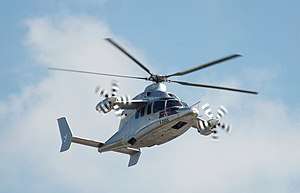Airbus RACER
The Airbus RACER (Rapid and Cost-Effective Rotorcraft) is an experimental high-speed compound helicopter developed by Airbus Helicopters from the Eurocopter X³. Revealed at the June 2017 Paris air show, final assembly will start in mid-2020 for a 2021 first flight. Cruising up to 400 km/h (216 kn), it aims for a 25% cost reduction per distance over a conventional helicopter.
| RACER | |
|---|---|
.jpg) | |
| RACER model at Paris Air Show 2017 | |
| Role | Experimental compound helicopter |
| National origin | Multinational |
| Manufacturer | Airbus Helicopters |
| First flight | planned Q4 2021[1] |
| Developed from | Eurocopter X³ |
Development

On 20 June 2017 at the Paris air show, Airbus Helicopters revealed a high-speed demonstrator configuration based on the X3 developed within the Clean Sky 2 research programme.[2] Its aerodynamic configuration was validated in 2017.[3] In February 2018, the 2,500 hp (1,900 kW) Safran Aneto-1X was preferred over the RTM322 initially selected, it is 25% more compact for the same power.[4]
By October 2018, design of key subsystems was completed before the first components started manufacturing with long-lead items, as the lateral drive shaft production began. GE's Avio Aero in Italy launched procurement and manufacturing of the lateral gear boxes housings, GE Aviation Systems in UK is building the wing’s titanium cradle, INCAS/Romaero in Romania started manufacturing the composite side panel and Aernnova in Spain the tail parts primary structure. The flight demonstration should open the flight envelope and assess performance, before demonstrating missions like EMS, SAR and private transport, maturing low-noise flight procedures.[3] Final assembly should start by mid-2020 for a 2021 first flight.[1]
Design
Optimised for a cruise over 400 km/h (216 kn), 50% faster than a conventional helicopter, it will consume 15% less fuel per distance at 180 kn (333 km/h) than an helicopter at 130 kn (241 km/h), and aim for a 25% cost reduction per distance. The lateral pusher propellers generate thrust and are isolated from passengers during ground operations by the box wings which serve to generate lift at cruise velocity. This allows the main rotor to be slowed by up to 15% as the craft's air speed increases and prevents the rotor blades breaking the sound barrier which would reduce performance.[5] Driven by two engines, of which one is capable of shutting down and restarting once inflight to save fuel and increase range, it will have a low weight and low maintenance hybrid metallic-composite airframe and lower weight high voltage direct current electrical generation.[2][5]
See also
- Fairey Rotodyne
- Sikorsky S-97
Related development
Aircraft of comparable role, configuration and era
Related lists
References
- Dominic Perry (24 April 2020). "Despite delays, high-speed Racer begins to take shape for Airbus Helicopters". Flightglobal.
- "Airbus Helicopters reveals Racer high-speed demonstrator configuration" (Press release). Airbus. 20 June 2017.
- "Racer high-speed demonstrator passes preliminary design review milestone" (Press release). Airbus. 16 October 2018.
- Thierry Dubois (February 27, 2018). "Airbus picks Safran's Aneto engine for Racer compound demonstrator". Vertical magazine.
- Perry, Dominic (9 April 2020). "Airbus Helicopters maintains Racer's pace despite delays". Flight Global.